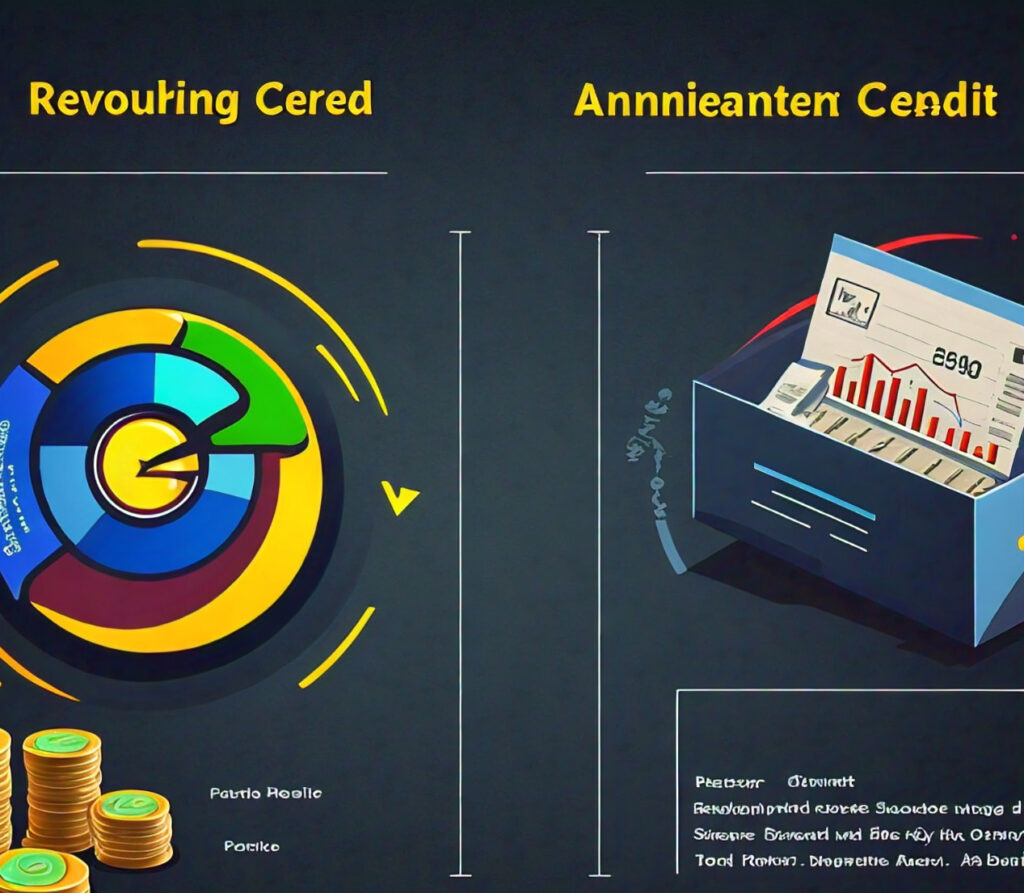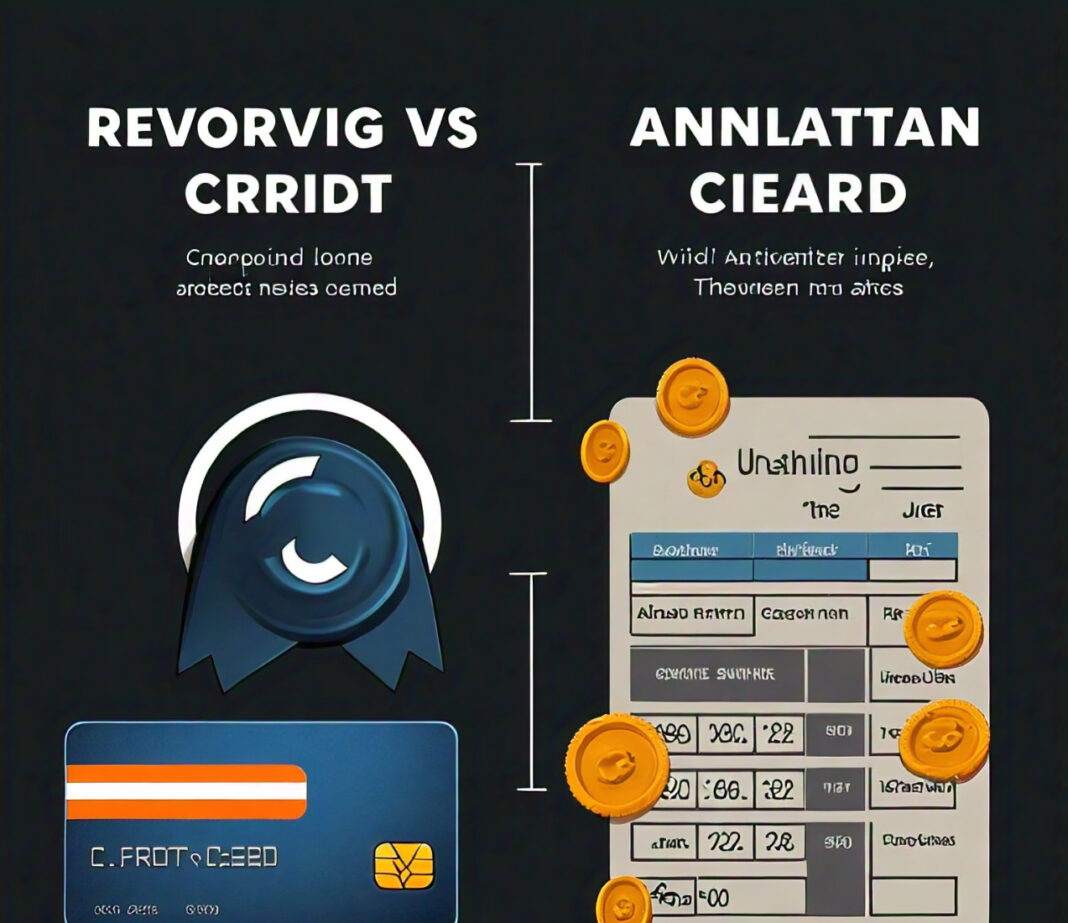Credit plays a significant role in most of our lives today. Whether it is a large purchase, funding for one’s education, or simply taking care of day-to-day expenses, knowing the various types of credit available will help someone make good decisions about their future financially. Probably the two most prevalent forms of credit are revolving credit and instalment credit. While both stand for the very purpose of lending money, they do function quite differently and can be suited for various kinds of financial needs.

Revolving and instalment credits look into their definitions, characteristics, advantages, and disadvantages will be discussed in this article. We will also look at how each of these types affects your credit score, look at examples of common credit products, and give you some kind of guidance on how to choose the type of credit that best suits your particular situation. By the end of this comprehensive guide, you will clearly understand these two credit types and be better equipped to navigate your borrowing options.
What is Revolving Credit?
Revolving credit is a type of credit extended to a borrower that provides a maximum limit that can be used, returned, and reused. It got the name “revolving” because this line of credit replenishes when you pay back your balance and allows you to borrow again and again up to your limit without having to reapply.
Key Features of Revolving Credit
- Flexible borrowing: You can borrow any amount up to your credit limit.
- Variable payments: Your monthly payment varies based on your current balance.
- Ongoing availability: So long as you do not exceed your limit, you can continue to borrow.
- Interest charges: You pay interest only on the amount you have borrowed.
- Minimum payments: You are often required to make at least a minimum payment each month.
Common Examples of Revolving Credit
- Credit cards: The most prevalent and pervasive form of revolving credit.
- Lines of credit: Personal lines of credit and HELOCs.
- Retail store cards: Credit cards offered by particular retailers.
Revolving Credit Pros
- Flexibility: borrow exactly the amount needed, at a time and in a quantity that suits your requirement.
- Convenience: ready access to funds for any purpose.
- Build credit quickly: Continued use with timely payments will increase credit score.
- Rewards: Most forms of revolving credit have either cashback, points, or miles.
Disadvantages of Revolving Credit
- Higher interest rates: Generally, they carry higher APRs compared to instalment loans.
- Overspending: Ease of access encourages debt building.
- Variable payments: This makes it more complicated to budget appropriately.
- High credit utilization risk: If you use too much credit, then that could drop your credit score.
What is Installment Credit?
Instalment credit is an advance in a lump-sum disbursement that is repaid, usually by regular instalments, over a fixed period. Each payment has a set amount that goes to the principal you owe, plus interest.
Main Features of Installment Credit
- Loan amount fixed: You are lent a certain amount of money right off the bat.
- Set repayment term: It provides for the payoff date for the loan.
- Fixed payments: Your monthly payments are usually the same during the loan term.
- Interest rate: This may be fixed or variable but is often lower than revolving credit.
- Closed-end credit: You close the account when the loan is repaid, and you must reapply to borrow again.
Common Examples of Installment Credit
- Mortgages: Long-term loans that finance home purchases.
- Auto loans: Taken out to purchase automobiles.
- Personal loans: For debt consolidation, home improvements, and many more.
- Student loans: Meant for educational expenses.
Benefits of Installment Credit
- Predictable payments: Payments are fixed and, therefore, easier to budget.
- Lower interest rates: Generally carry lower APRs than revolving credit.
- Larger loan amounts: Can be used for significant purchases or expenses.
- Structured repayment: Provides a clear path to becoming debt-free.
Disadvantages of Installment Credit
- Less flexibility: You cannot borrow any portions that you’ve paid without applying for a new loan.
- Potential for prepayment penalties: You may be charged if you repay a loan before the end of the term.
- Commitment: You are under obligation to repay in full, even when the funds may no longer be needed.
- Collateral requirements: Some instalment loans, such as mortgages, may require assets as security.
How Revolving and Installment Credit Affect Your Credit Score
This affects both revolving and instalment credit, although the way it occurs is different. Knowing the difference is helpful in managing your credit effectively.
Impact of Revolving Credit on Credit Scores
- Credit Utilization: This is the percentage of available credit used by you, which is a major basis for your credit score. Low utilization, normally under 30 per cent, is good for the score.
- Payment history: A history of consistent, on-time payments boosts your score.
- Length of credit history: Revolving accounts that have aged well, wherein you’ve had the same revolving credit for many years, do help.
- Credit mix: Revolving credit used in your total credit will be beneficial.
How Installment Credit Affects Credit Scores
- Payment history: On-time, consistent payments will help your score.
- Credit mix: An instalment loan mix within your credit history will showcase that you can manage multiple types of credit.
- Length of credit history: Long-term instalment loans can help improve the length of your credit history.
- Amounts owed: As you start paying down installment loans, the balance paid decreases and hence positively impacts your score.
How to Decide Between Revolving and Installment Credit
Revolving credit and instalment credit are both used when it comes to your financial needs, goals, and circumstances. Here are a number of factors that determine which type of credit to use:
When to Opt for Revolving Credit
- Revolving credit: For daily, variable expenses such as groceries or utility bills.
- Emergency fund: In case something comes up and you need it.
- Build credit quickly: Credit will be used frequently and returned upon demand for quick improvement.
- Rewards: If able to be paid in full and desire rewards given as cashback or points.
When to Choose Installment Credit
- Major, one-time purchases: Like a home or a car.
- Predictable expenses: When you need a fixed amount and seek regular payments.
- Debt consolidation: To combine high-interest debts into one and pay them off.
- Long-term financial planning: To finance large life occasions such as education.
Managing Revolving and Installment Credit Responsibly
Whichever type of credit is used, making sure to manage it responsibly will be the determining factor in how well you maintain your financial health and strong credit score.
Tips for Managing Revolving Credit
- Utilization Should Be Low: Make it a point to use less than 30% of the credit that is available to you.
- Pay More than the Minimum: If possible, pay the entire monthly balance and avoid interest charges.
- **Track Your Accounts: You have to check your statement every month for errors or any fraudulent activity.
- Consider extra payments: Where your budget allows for it, paying extra can save interest and shave time off the loan.
- Understand your terms: Remember any prepayment penalties or variable interest rates.
- Don’t overborrow: Leave room in your budget to make the payments comfortably.
The Role of Credit Scores in Obtaining Revolving and Installment Credit
Your credit score has a great effect on the revolving credit and instalment credit that you would get approved for. Here’s how it applies to each type:
Credit Scores and Revolving Credit
- Approval odds: The better the rating, the higher the likelihood of getting approved for credit cards and lines of credit.
- Credit limits: The better the rating, the higher the credit limit.
- Interest rates: The interest rate is normally lower for those with high scores.
- Rewards and perks: If you want premium cards with better rewards, great credit is a common requirement.
Credit Scores and Installment Credit
- Getting approved for a loan: The better your score, the more likely you’ll be approved for a loan.
- Interest rates: With a good score, you’re likely to get lower interest rates, which could save you thousands over the life of a loan.
- Loan terms: You could have access to more favourable repayment terms when you have a good credit score.
- Down payment requirements: For secured loans, the higher the score, the lower the down payment may be.
The Future of Revolving and Installment Credit
Financial technology continues to evolve, as do credit products. Following are some trends in the development of the future of revolving and instalment credit:
- Buy Now, Pay Later (BNPL): This newer hybrid model provides instalment payments for purchases, which can be quite small.
- AI-driven credit decisions: With increasingly accurate risk assessment, personalized credit offers are possible.
- Open banking: Further increases in access to financial data could lead to the development of more innovative credit products.
- Mobile-first credit solutions: Credit will be easier to access and manage on mobiles.
Conclusion
Knowing the difference between revolving and instalment credit is key to making informed decisions about your money. Both serve different purposes and come with a different set of pros and cons that may tag along with them. Revolving credit offers flexibility and convenience for ongoing or unexpected expenses, while instalment credit provides structure and predictability for large, one-time purchases or long-term financial goals.
A decision between revolving and instalment credit should consider your specific financial need, your ability to use credit responsibly, and your long-term financial goals. Many times, a combination of both types gives you a well-rounded approach to credit use, thus potentially improving your credit mix and overall financial health.
Whatever type of credit you choose, remember that the secret to financial success is responsible borrowing and consistent, on-time payments. If you are aware of your options and use credit responsibly, these financial instruments can help you reach your goals while retaining a healthy credit profile.
The wise thing to do as you take on your credit journey is not to worry about seeking advice from financial professionals, especially when you are making major borrowing decisions. Keep up with your credit score, review the reports regularly, and always borrow within your means. With the right approach, both kinds of credit-revolving and instalment-can turn out to be an important addition to your financial toolbox and will help you plan out a secure and flourishing financial future.






